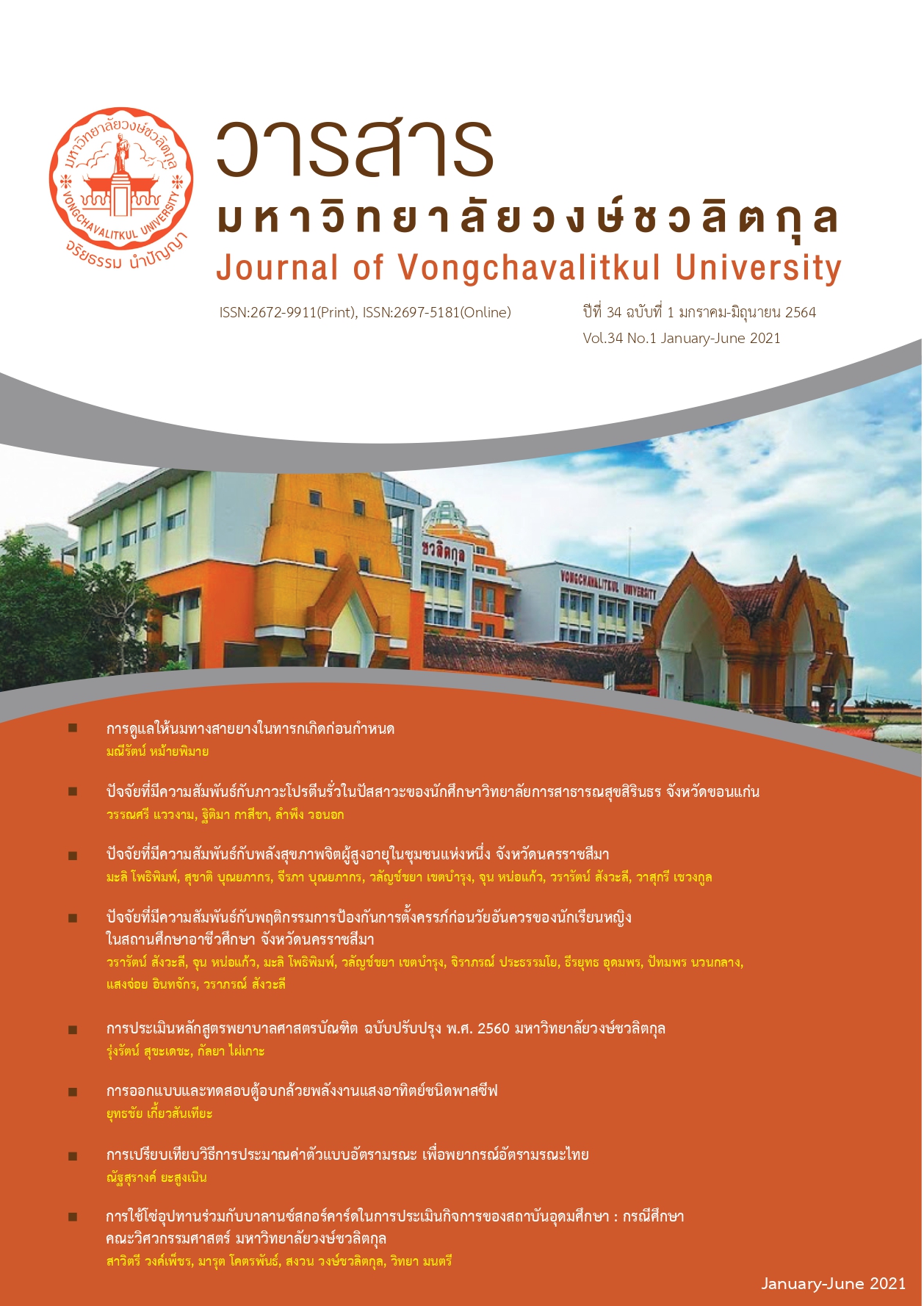Caring for Preterm Infants with Enteral Tube Feeding
Main Article Content
Abstract
The sucking, swallowing, and breathing in the preterm infants are not well coordinated due to neurological immaturity, causing them a difficulty in suckling. Enteral tube feeding is helping preterm infants get enough nutrients to meet their nutritional needs. It is a common nursing activity in a sick newborn ward. If nurses do not perform care correctly or lack of awareness in each step, the preterm infants may be at risk of complications. The most common complication is aspiration pneumonia. Therefore, nurses require to have knowledge, skills, and awareness in all steps of enteral tube feeding to reduce the possibility of those risks, increase safety for the premature infants with enteral tube feeding, leading to an effective care outcome, and cost reduction for the medical treatment.
Article Details
References
2. เต็มดวง บุญเปี่ยมศักดิ์. (2558). การให้อาหารทางสายยาง (Enteral tube feeding). ใน วิทยาลัยพยาบาลสภากาชาดไทย ภาควิชาการพยาบาลเด็กและการผดุงครรภ์ (บรรณาธิการ), หัตถการเบื้องต้นทางการพยาบาลเด็ก (หน้า 85- 96). กรุงเทพฯ: โรงพิมพ์แห่งจุฬาลงกรณ์มหาวิทยาลัย.
3. นฤมล ธีระรังสิกุล. (2545). การพยาบาลทารกคลอดก่อนกำหนด. ใน นฤมล ธีระรังสิกุล (บรรณาธิการ), ปัญหาที่พบบ่อยในทารกที่คลอดก่อนกำหนด (หน้า 35-74). กรุงเทพฯ: พี เพลส.
4. พรรณรัตน์ แสงเพิ่ม. (2559). การเลี้ยงลูกด้วยนมแม่ในทารกแรกเกิดที่มีความเสี่ยงสูง (Breastfeeding in high-risk infants). ใน วัลยา ธรรมพนิชวัฒน์ สมสิริ รุ่งอมรรัตน์ และสุดาภรณ์ พยัคฆเรือง (บรรณาธิการ), การพยาบาลทารกแรกเกิดที่มีความเสี่ยงสูง (หน้า 78-96). กรุงเทพฯ: โครงการตำราคณะพยาบาลศาสตร์ มหาวิทยาลัยมหิดล.
5. มณีรัตน์ หม้ายพิมาย. (2562). การพยาบาลผู้ป่วยที่มีปัญหาด้านการรับประทานอาหาร (Nursing for nutrition needs). ใน สิริรัตน์ ฉัตรชัยสุชา มธุสร ปลาโพธิ์ และต้องตา ขันธวิธิ (บรรณาธิการ), หลักการและเทคนิคการพยาบาล (Principles and techniques in nursing) (หน้า 135-143). นครราชสีมา: สมบูรณ์การพิมพ์.
6. วรมินทร์ เหรียญสุวรรณ. (2560). Enteral nutrition indications and contraindication and route access. ใน ส่งศรี แก้วถนอม บุชชา พราหมณสุทธิ์ อรวรรณ พิชิตไชยพิทักษ์ สิริกานต์ เตชะวณิช และอุปถัมภ์ ศุภสินธุ์ (บรรณาธิการ), พยาบาลโภชนบำบัด Nutrition support nurse (2) (หน้า 135-154). กรุงเทพฯ: กรุงเทพเวชสาร.
7. สุพร ตรีพงษ์กรุณา. (2549). การให้อาหารทางสายและการดูแล. ใน วันดี วราวิทย์ สุพร ตรีพงษ์ กรุณา เกศรา อัศดามงคล ประพันธ์ อ่านเปรื่อง และบุษบา วิวัฒน์เวคิน (บรรณาธิการ), แนวเวชปฏิบัติโรคทางเดินอาหารในเด็ก (หน้า 470-481). กรุงเทพฯ: โรงพิมพ์บียอนด์เอ็นเทอร์ไพรซ์.
8. หทัยชนก นิติกุล, สุดาภรณ์ พยัคฆเรือง, นงลักษณ์ จินตนาดิลก และจันทนา พันธ์บูรณะ. (2557). ผลของการจัดท่านอนขณะและหลังให้นมทางสายให้อาหารต่อความสามารถในการรับนมในทารกเกิดก่อนกำหนดที่มีน้ำหนักตัวน้อย. วารสารสภาการพยาบาล (Thai Journal of Nursing Council), 29(4), 32-44. Retrieved from https://he02.tci-thaijo.org/index.php/TJONC/article/view/2763
9. Ameri, G., Rostami, S., Baniasadi, H., Aboli, B., & Ghorbani, F. (2018). The effect of prone position on gastric residuals in preterm infants. Journal of Pharmaceutical Research International, 22(2), 1-6.
10. Braegger, C., Decsi, T., Dias, J. A., Hartman, C., Kolacek, S., Koletzko, B., Koletzko, S., Mihatsch, W., Moreno, L., Puntis, J., Shamir, R., Szajewska, H., Turck, D., van Goudoever, J., & ESPGHAN Committee on Nutrition. (2010). Practical approach to paediatric enteral nutrition: A comment by the ESPGHAN committee on nutrition. Journal of pediatric gastroenterology and nutrition, 51(1), 110-122.
11. Brune, K. D., & Donn, S. M. (2018). Enteral feeding of the preterm infant. NeoReviews, 19, e645-e653.
12. Cooke, R. J., & Embleton, N. D. (2000). Feeding issues in preterm infants. Archives of disease in childhood. Fetal and neonatal edition, 83(3), F215-F218.
13. Dodrill, P. (2011). Feeding Difficulties in Preterm Infants. ICAN Infant Child & Adolescent Nutrition, 3(6), 324-331.
14. Dutta, S., Singh, B., Chessell, L., Wilson, J., Janes, M., McDonald, K., Shahid, S., Gardner, V. A., Hjartarson, A., Purcha, M., Watson, J., de Boer, C., Gaal, B., & Fusch, C. (2015). Guidelines for feeding very low birth weight infants. Nutrients, 7(1), 423-442.
15. Groh-Wargo, S., & Sapsford, A. (2009). Enteral nutrition support of the preterm infant in the neonatal intensive care unit. Nutrition in clinical practice: official publication of the American Society for Parenteral and Enteral Nutrition, 24(3), 363-376.
16. Kültürsay, N., Bilgen, H., & Türkyılmaz, C. (2018). Turkish neonatal society guideline on enteral feeding of the preterm infant. Turkish Archives of Pediatrics/Türk Pediatri Arşivi, 53, S109-S118.
17. Mora, J., Punthmatharith, B., & Wattanasit, P. (2017). Effect of positioning on gastric residual volume in preterm infants. Songklanagarind Journal of Nursing, 37(4), 35-46. Retrieved from https://he02.tci-thaijo.org/ index.php/nur-psu/article/view/ 107742
18. Örs, R. (2013). The practical aspects of enteral nutrition in preterm infants. Journal of pediatric and neonatal Individualized medication, 2(1), 35-40.
19. Parker, L. A., Weaver, M., Murgas Torrazza, R. J., Shuster, J., Li, N., Krueger, C., & Neu, J. (2019). Effect of gastric residual evaluation on enteral intake in extremely preterm infants: A randomized clinical trial. JAMA pediatrics, 173(6), 534-543.


